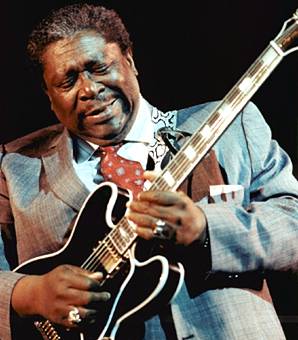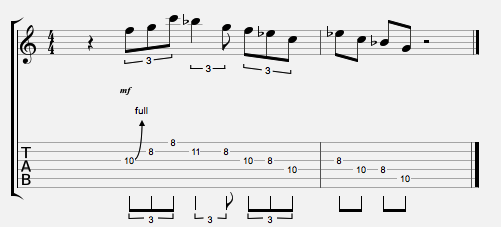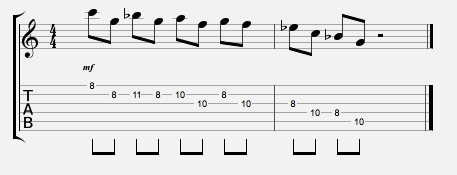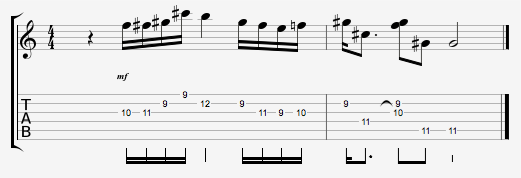Blues Turnarounds for Guitar
By Sam Smiley
Blues Turnarounds are an extremely important part of the blues form. Playing the right things at the right time, especially in the turnaround, can take your blues playing from ‘hacky’ to authentic in no time. The blues turnaround happens in the last bar of the 12 bar blues form. Usually, the band goes to the V chord here (in the key of C, this would be the G chord).

It’s important to think about context whenever you’re learning a vocabulary of music, whether it’s blues, jazz, rock, country, anything. It’s not enough to just know the licks for a certain style of music, you also have to know how and where to use them. The blues gives us 5 very distinct places to use different vocabulary – the I chord, IV chord, V chord, turnaround, and endings.
Each section of the blues has a vocabulary to it that is specific to that section. One mark of an inexperienced blues player (or one who hasn’t done their homework) is slapping a blues scale over the entire progression. When you hear a player who doesn’t do anything to distinguish between the I chord and the turnaround, your ear starts to tire it sounds like ‘the same old blues licks.’
Of course many players use the vocabulary in different places and it still sounds great. My recent eBook, Blues Language, is a study on the greatest blues players’ licks for each section of the blues. By working through the vocabulary of the blues in this way you will cut almost all the fat and sound authentic very quickly.
In this lesson we’ll take a look at some of the greatest blues players’ blues turnaround licks.
Blues Turnaround Characteristics
I studies hundreds of licks when writing Blues Language, and found a couple things that made up the licks at the turnaround section. If you apply these characteristics even in making up your own blues turnaround licks you will sound authentic.
- Go to the 5th degree of the scale or the V chord – almost all the licks that happen in the blues turnaround section move to the V chord or the 5th degree. This makes a lot of sense since that is the chord there, but the frequency in which players play or clearly outline the 5 is much higher than any other section of the blues form.
- End the lick on the and of 2 or 3 – These licks also share a rhythmic characteristic of ending on the and of 2 or 3. My guess is that this is holdover from the delta blues days. Well really the whole vocabulary is a holdover! But this in particular has hardly changed from the days of Charley Patton.
Blues Turnaround Licks
Eric Clapton
The first two licks we’ll look at come from Eric Clapton and his From the Cradle album (an excellent classic blues record from Clapton’s later library). These first two licks are both in the key of C. Notice that the ending of each is the same – they both follow a pentatonic line down to the 5th of the key (G in this case). Using this idea is the quickest way to really get the blues vocabulary working in your playing. Ending licks on the 5th degree on that last bar will give your blues playing a very authentic sound.
Lick one

Lick two

BB King
BB King played, and created, some of the most classic electric blues vocabulary. He is after all the king of the blues. This lick is packed with great stuff that you can extrapolate and use in other contexts. The lick is in the key of C#, and is based around the “E” chord shape on the 9th fret. He uses a technique called enclosure, by playing notes chromatically around the 3rd of the chord during the last beat in the first measure – he’s highlighting the E# or F note. Notice that he also ends the lick on the 5th of the chord, this time using more chord tones than pentatonic scale.

Earl Hooker
The last blues turnaround lick we’ll look at comes from the unsung blues master, Earl Hooker. Many of the greats (including Buddy Guy) continually cited Hooker as being the best guitarist of all the Chicago players, but personality quirks kept him from maintaining the high profile that Albert King, Guy, and Freddie King had.
This blues turnaround lick in D has a great walk-up from the 3rd to the 5th of the D chord. Notice that he moves chromatically down and back up, but in triplets as he moves up. The lick ends with the classic V chord – not just the 5th degree of the scale but the whole chord!

What songs do you feel like have perfect blues turnaround licks? Please comment below and come over and visit my page as well at www.samsmileymusic.com.
Sam Smiley
is a multi-styled guitarist. After being schooled in the jazz tradition, he has found way to meld all American roots music into his own unique style. As a musician, he performs regularly playing anything from blues to jazz to country to soul. He has traveled the world performing in clubs and in theaters.
He also is the owner of Sam Smiley Music where he writes extensively on jazz, country, and blues. His unique musical identity shines through his writing as he brings readers in direct contact with the music of the masters. As an author he has been featured in Just Jazz Guitar, Making Music, Mel Bay Sessions, Jamie Holroyd Guitar, and Matt Warnock Guitar.
Sam teaches commercial guitar at the University of Saint Francis and is at the forefront of modern education methods, offering Skype and Bespoke Video lessons from his studio.
Sam has also written the fantastic book “Blues Language” – A bible for guitarists who want to play authentic blues guitar.
“The artists you work with, and the quality of your work speaks for itself.”
Tommy Emmanuel
© Copyright Fundamental Changes Ltd 2025
No.6 The Pound, Ampney Crucis, England, GL7 5SA
